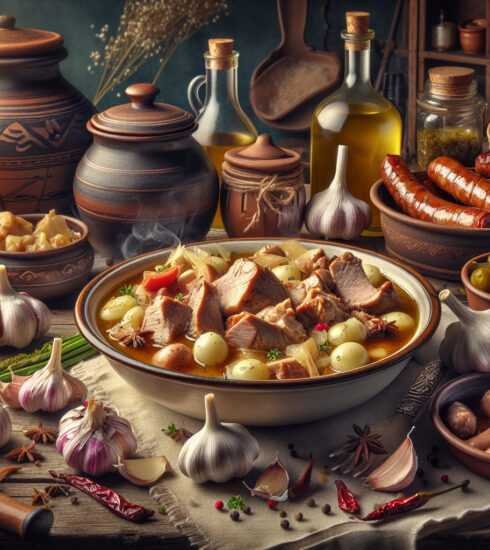Unveiling Hungarian Cuisine: Dive into the Fascinating Stories of Culinary Traditions – A Must-Read Article for Food Enthusiasts!
Unearthing Treasures: Exploring the Untold Stories of Hungarian Cuisine
Hungarian cuisine is a treasure trove of flavors, a tapestry woven with centuries-old traditions and influences from neighboring countries. From hearty stews and spicy sausages to delicate pastries and rich desserts, Hungarian cuisine reflects the country’s history, geography, and diverse cultural heritage. In this article, we will embark on a gastronomic journey through the rich culinary landscape of Hungary, unearthing the untold stories behind its iconic dishes and exploring the flavors that make Hungarian cuisine truly unique.
The Influences Behind Hungarian Cuisine
Hungarian cuisine is a fusion of various culinary traditions, shaped by the country’s complex history. Situated in Central Europe, Hungary has been a crossroads of cultures for centuries, resulting in a diverse culinary heritage. The influences on Hungarian cuisine can be traced back to the medieval Kingdom of Hungary, the Ottoman Empire, and the Austro-Hungarian Empire, which further enriched the culinary traditions.
Among the earliest influences on Hungarian cuisine are the Magyars, the nomadic people who settled in the Carpathian Basin in the 9th century. The Magyars introduced a nomadic lifestyle and a unique cooking style that relied heavily on meat, dairy products, and spices. Elements of this ancient cooking style can still be found in modern Hungarian cuisine.
In the 16th century, Hungary was conquered by the Ottoman Empire, leading to the introduction of exotic spices and new cooking techniques. The Ottomans brought ingredients such as paprika and introduced the use of open-fire cooking, which revolutionized Hungarian cuisine. Since then, paprika has become an essential ingredient in many Hungarian dishes, giving them their distinctive flavors and vibrant colors.
In later centuries, Hungary became a part of the Austro-Hungarian Empire, which further shaped the country’s culinary traditions. The Austrians brought their own recipes and cooking techniques, resulting in the fusion of Austrian and Hungarian flavors. This culinary fusion can be seen in dishes such as Wiener Schnitzel, which has become a popular dish in Hungary.
Regional Variations in Hungarian Cuisine
While Hungarian cuisine has a strong culinary identity, there are notable regional variations that add depth and diversity to the country’s gastronomy. Each region in Hungary has its own unique dishes and flavors, influenced by local ingredients and cultural traditions. Some of the prominent regional variations include:

- Transylvanian Cuisine: Located in the central part of Romania, Transylvania was once a part of Hungary. Transylvanian cuisine is characterized by its use of rich flavors and hearty ingredients. Traditional dishes include Transylvanian goulash, pork stew with sauerkraut, and Szekler-style cabbage rolls.
- Southern Hungarian Cuisine: The southern region of Hungary is known for its spicy flavors and vibrant dishes. Dishes like fisherman’s soup, which is made with freshwater fish and spicy paprika, and the famous Szeged-style paprika sausage are popular in this region.
- Great Plain Cuisine: The Great Plain, or Puszta, is a vast, flat region in Hungary, known for its agricultural heritage. Dishes in this region tend to be hearty and filling, such as Hortobágyi-style pancakes, which are savory pancakes filled with meat and served with a paprika sauce.
- Mátra Mountain Cuisine: Located in the northeastern part of Hungary, the Mátra Mountains offer a unique culinary experience. The region is known for its game dishes, such as venison stew, and its hearty soups, which are perfect for the cold mountain weather.
These regional variations in Hungarian cuisine showcase the diverse flavors and local ingredients that contribute to the country’s culinary tapestry. Exploring different regions of Hungary offers a chance to uncover lesser-known dishes and discover the hidden gems of Hungarian gastronomy.
The Cornerstones of Hungarian Cuisine
Although Hungarian cuisine is rich in diverse flavors and regional specialties, there are a few dishes that serve as the cornerstones of Hungarian gastronomy. These dishes have become iconic representations of Hungarian flavors and are a must-try for any food lover visiting Hungary.
Goulash
Goulash is perhaps the most famous Hungarian dish, known and loved around the world. Originally a humble stew made by Hungarian herdsmen, goulash has evolved into a rich and flavorful dish that symbolizes Hungarian cuisine. The traditional Hungarian goulash is a hearty soup made with tender beef, onions, paprika, and other spices. It is usually served with bread or dumplings, making it a filling and satisfying meal.
Goulash is a perfect example of the fusion of different culinary influences on Hungarian cuisine. The use of paprika reflects the Ottoman influence, while the hearty ingredients and slow-cooking method showcase the Hungarian love for comfort food.
Lángos
Lángos is a popular Hungarian street food that has gained a cult following in recent years. It is essentially a deep-fried flatbread topped with various savory or sweet toppings. The dough is made from flour, yeast, water, and salt, and is deep-fried until golden and crispy. It is then topped with ingredients such as sour cream, cheese, garlic, or Nutella.

Lángos is a beloved comfort food in Hungary, often enjoyed as a quick and satisfying snack. It can be found in food markets, street food stalls, and even specialized lángos shops throughout the country. Lángos is a versatile dish that can be customized with a wide range of toppings, making it a favorite among locals and tourists alike.
Dobos Torte
No exploration of Hungarian cuisine would be complete without indulging in the country’s famous desserts. Dobos Torte, also known as Dobosh cake, is a layered sponge cake with a rich chocolate buttercream filling. The cake is topped with caramel and sliced into individual portions, making it an elegant and decadent dessert.
The Dobos Torte was created by Hungarian confectioner József C. Dobos in the late 19th century and quickly became a sensation in Budapest. The cake’s intricate layers and caramel topping made it a showstopper at social events and celebrations. Today, Dobos Torte is still a beloved dessert in Hungary and can be found in many traditional pastry shops and cafes.
Hungarian Flavors in Budapest
Budapest, the capital city of Hungary, is a vibrant culinary destination that offers a wide range of dining experiences. From traditional Hungarian taverns to innovative fine dining restaurants, Budapest has something to satisfy every palate. Here are a few must-try Hungarian flavors in Budapest:
Gundel Restaurant
Gundel Restaurant is a legendary establishment in Budapest, known for its classic Hungarian cuisine and elegant atmosphere. Founded in 1894, Gundel Restaurant has been a gathering place for artists, politicians, and food enthusiasts for over a century.
Some of the signature dishes at Gundel include chicken paprikash with Hungarian-style dumplings, crispy duck breast with foie gras, and Gundel pancake, a crepe filled with walnuts and chocolate sauce. For a truly indulgent experience, try the Gundel palacsinta, a savory pancake filled with veal and served with a paprika sauce.
Giglio Rosso







ᐈ Delightful Hungarian Delights: Explore the Rich and Captivating Cuisine of Hungary. Enjoy, Discover, and Indulge in the Sensory Delights of Hungary.
9 months ago[…] more information on Hungarian delights, consider reading the articles available at Hungary-Trip and […]